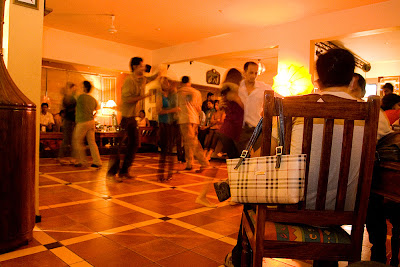 For a long time i pushed these images to the abyss of my hard disk simply because, i kept having this nagging feeling that i was missing something in this story. May be i would find it if i went back to the story. May be i just need a little more patience. May be i need to put in a little more effort. Or may be, i should learn salsa!
In any case, ive put my story together now. The story of what i think is the most fashionable art form in the city. Told as i saw it, with the hope that i will return to it this year.
For a long time i pushed these images to the abyss of my hard disk simply because, i kept having this nagging feeling that i was missing something in this story. May be i would find it if i went back to the story. May be i just need a little more patience. May be i need to put in a little more effort. Or may be, i should learn salsa!
In any case, ive put my story together now. The story of what i think is the most fashionable art form in the city. Told as i saw it, with the hope that i will return to it this year.
 To me, the workshops associated with the Salsa Congress seemed to be the most exciting part of the event. The area cordoned off for the workshops were thronging with people... be it a workshop on salsa, bollywood or hip hop!
To me, the workshops associated with the Salsa Congress seemed to be the most exciting part of the event. The area cordoned off for the workshops were thronging with people... be it a workshop on salsa, bollywood or hip hop!





 Whatever people say about sexism, prejudices against women, violence, equal rights etc etc I might count as someone who has always been glad to have been born a woman. How else would you remember the occasion when you casually walked into a restroom to find it turned into a green room by the dancers and all you had to do to get permission to shoot was to ask whether they'd mind if you took pictures of them while they were dressing! Getting access to shoot, (I'm sure most of you would agree) is one of the most important part of your work as a photojournalist. But to walk into such unprecedented scenarios and to earn the trust of your subjects because you share a common understanding of the unwritten rules of the feminine world is much more than a happy coincidence. I knew how far i could go with my privileged access and they knew that i need not be told. We all respected each other for that. It's a pity i don't have any of their contact information. But its a small world. I'm hoping one of them would read this blog and see their pictures some day. My friends from the green room...
Whatever people say about sexism, prejudices against women, violence, equal rights etc etc I might count as someone who has always been glad to have been born a woman. How else would you remember the occasion when you casually walked into a restroom to find it turned into a green room by the dancers and all you had to do to get permission to shoot was to ask whether they'd mind if you took pictures of them while they were dressing! Getting access to shoot, (I'm sure most of you would agree) is one of the most important part of your work as a photojournalist. But to walk into such unprecedented scenarios and to earn the trust of your subjects because you share a common understanding of the unwritten rules of the feminine world is much more than a happy coincidence. I knew how far i could go with my privileged access and they knew that i need not be told. We all respected each other for that. It's a pity i don't have any of their contact information. But its a small world. I'm hoping one of them would read this blog and see their pictures some day. My friends from the green room...





The Evening Show begins!










































